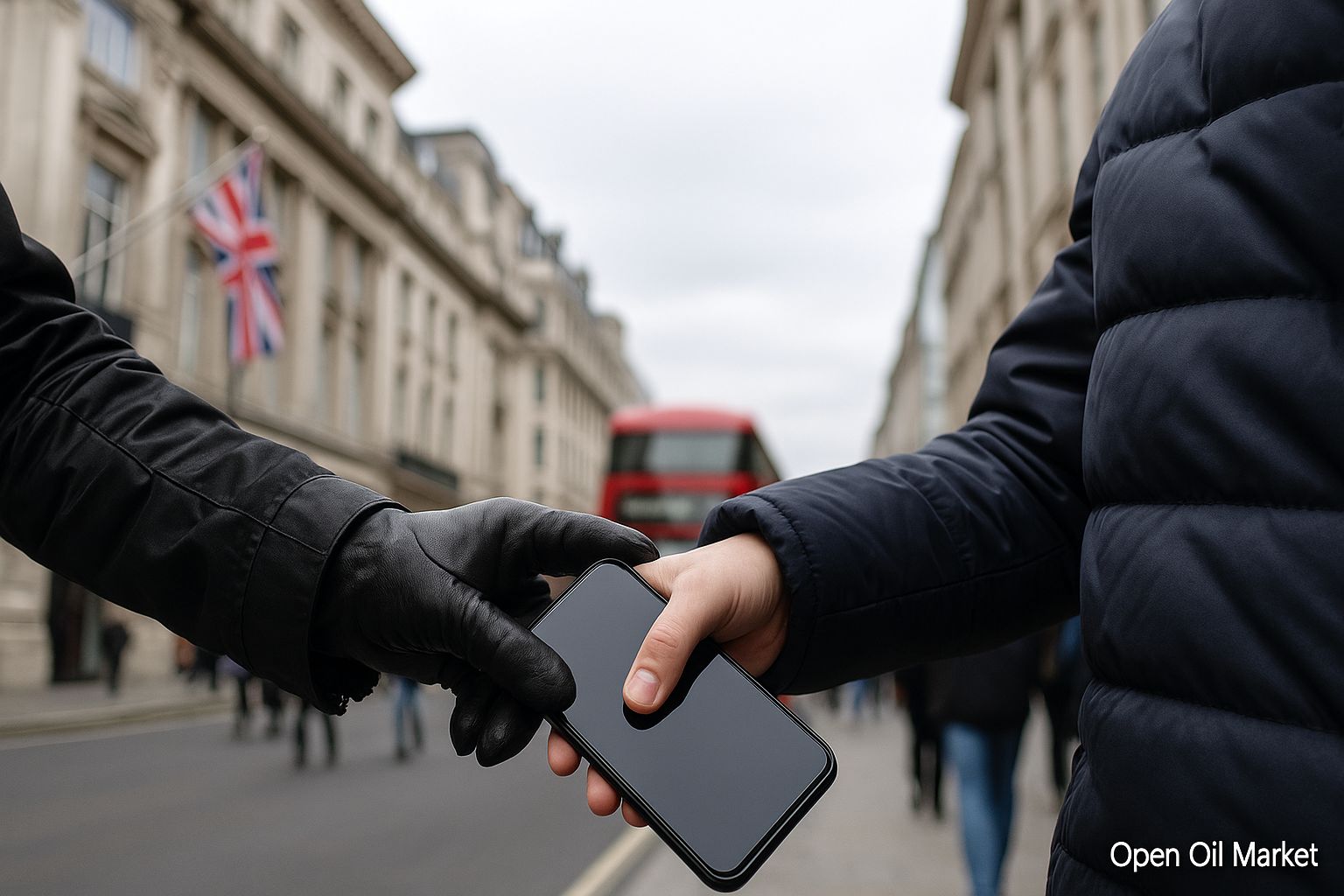
In 2025, the UK Emerged as the Leader in Europe for Mobile Phone Theft
The UK has emerged as the leader among European countries for mobile phone theft, according to a report by the American insurance company SquareTrade, which operates in 12 European countries. The analysis revealed that nearly 40% of all smartphone theft claims made by customers in Europe originated from the United Kingdom. Notably, British users comprise only about 10% of SquareTrade's customer base, indicating an disproportionately high level of mobile thefts in the country.
Scale of Smartphone Theft in Britain
According to SquareTrade, the UK accounts for 39% of all mobile device thefts recorded in Europe, meaning that two out of every five stolen phones in Europe are taken in Britain. This statistic places the country significantly ahead of other nations involved in the study. For comparison, despite such a high percentage of thefts, British clients make up only around 10% of SquareTrade's European customer base, underscoring the disproportionate frequency of mobile thefts in the UK relative to the European average.
Surge in Theft Incidents
The UK has experienced a dramatic rise in mobile phone thefts. Compared to 2021, the number of such crimes in the country has increased more than fivefold. By June 2025, the total number of reported smartphone thefts grew by 425% relative to the level seen in the summer of 2021. Experts indicate that this trend reflects the emergence of a new criminal phenomenon. On average, approximately 230 phones are stolen each day, nearly double the rate from five years ago. The rapid growth of these figures indicates that gadget thefts have become one of the fastest-spreading categories of crime.
Official data from the police in England and Wales corroborate the overall trend: in 2024 alone, the number of street thefts rose by 50%, reaching 483,000 incidents, with mobile phones being the primary target of such crimes.
London as the Epicenter of Crime
A significant portion of the overall theft statistics can be attributed to the UK capital. London accounts for 42% of all phone thefts in the country, equating to 16% of the total number recorded across Europe. In 2024, the city witnessed over 70,000 mobile phone thefts, marking a 40% increase compared to the previous year. For context, in 2020, metropolitan police reported around 20,000 such crimes annually. The sharp increase over just a few years has turned smartphone thefts in London into a problem of unprecedented scale.
Representatives of the London police describe the situation as an emerging "epidemic" of crimes orchestrated by organized groups. According to estimates from Scotland Yard, the annual financial impact of phone thefts on London residents and visitors is at least £70 million. The average value of each stolen device is around £1,200, with approximately 80% of stolen gadgets being iPhones. Phones are particularly often stolen during the summer months and around Christmas, when the streets are filled with people and tourists. Moreover, the actual number of thefts may be even higher than official statistics suggest, as many victims do not report incidents to the police.
Street Thieves' Tactics
Most smartphone thefts follow a similar pattern. Perpetrators act boldly and swiftly: they typically snatch phones right from their owner's hands in public spaces and immediately flee. For these purposes, scooters and modified electric bicycles, capable of reaching speeds of up to 100 km/h or more, are frequently used. Criminals often operate in pairs: one rides the vehicle while the other quickly grabs the phone, speeding past an unsuspecting victim. This method allows thieves to execute a series of thefts in a short time frame, leaving victims little chance to react.
After grabbing a smartphone, thieves quickly try to eliminate the possibility of tracking the device. They may switch the phone to "airplane mode," place it in a special bag (known as a Faraday bag), or simply wrap it in aluminum foil to block GPS and mobile signals. Some devices are hurriedly discarded in predetermined locations (such as bushes), from where accomplices later retrieve them. Police representatives note that modern criminal groups are well-informed about technology and rapidly adapt their methods to minimize the risk of capture and tracking of the stolen devices.
Criminal Preferences: Premium Models
Thieves primarily target expensive smartphone models that can be profitably resold. Statistics from SquareTrade indicate that about 80% of stolen phones are Apple products, specifically the latest iPhones. The flagship devices from this brand and other leading manufacturers hold significant value on the black market, yielding considerable profits upon resale. The average insurance payout for a stolen smartphone in the UK is approximately £1,200, reflecting the high value of the stolen devices.
Organized Gangs and Drivers Behind the Surge
The spike in mobile phone thefts is often linked to the resurgence of organized criminal groups. Police representatives note that many of these gangs previously engaged in drug trafficking (the so-called "county lines"), but are now increasingly shifting towards smartphone thefts as a safer and more lucrative form of criminal enterprise. James Conway, commander of the London police's street robbery unit, emphasizes that the demand for modern gadgets in foreign markets has created ample opportunity for criminals to generate "huge profits" with a comparatively low risk. The penalties for a series of property thefts for young offenders are significantly lighter than for drug-related crimes, leading gangs to often recruit teenagers and young adults for phone theft schemes. For them, stealing smartphones becomes an easy way to earn money quickly while largely avoiding severe consequences.
International Network: Where Do Stolen Devices Go?
A significant portion of smartphones stolen in the UK soon leaves the country. According to police estimates, up to 80% of stolen phones from London are channeled abroad through established distribution networks. These devices are dispatched in batches to international markets, where they are resold as complete units or dismantled for parts. Journalists have found that the most common final destinations of these "exported" smartphones are countries in Africa and Asia: around 30% of stolen London phones are sent to Algeria, about 20% to China, and about 7% to Hong Kong. The remainder are sold in other countries or through the domestic black market. An extensive global network of resellers facilitates the rapid disposal of stolen gadgets where demand is high. Experts estimate that tens of millions of used smartphones are imported into such regions each year, making it easy for British criminals to find buyers abroad.
Countermeasures and Prospects
The wave of smartphone thefts in the UK has already drawn government attention and necessitates a comprehensive response. The Home Office has announced plans to increase patrols in the most crime-ridden areas and during "peak hours" in public spaces to curb the activity of thieves. London authorities are also experiencing pressure, with Mayor Sadiq Khan facing criticism from council opponents for insufficient focus on the issue, demanding more decisive action. In response, the Mayor states that the city is allocating record funding for police efforts to combat this crime epidemic.
The police, for their part, urge technology companies to join in solving the problem. Scotland Yard's leadership is proposing that smartphone manufacturers such as Apple and Google implement features designed to render stolen devices unsellable. For instance, there is consideration of the quick shutdown of access to cloud services and accounts on stolen phones, preventing criminals from capitalizing on the device or its data. Apple indicates that it has already invested significantly in user protection (such as in activation lock and remote data wipe systems), but law enforcement believes that new solutions are necessary to further diminish the appeal of smartphone thefts.
A New Reality for Smartphone Owners
The situation in the UK vividly demonstrates how the modern smartphone has transformed from a common communication tool into a target for street criminals. The country's leadership in theft rankings simultaneously reflects a high level of expensive gadget ownership and the activity of organized criminal networks. Experts believe that combating this threat can only be achieved through comprehensive measures:
- increased patrols in high-crime areas
- harsher penalties for gadget thefts
- implementation of technical solutions that "neutralize" stolen devices
- increasing public vigilance and crime prevention efforts
Smartphone users are advised to exercise caution in public spaces and to promptly block access to their devices if lost. The British experience serves as a warning for other megacities: without decisive action, the problem of mobile phone theft could expand into other countries.




